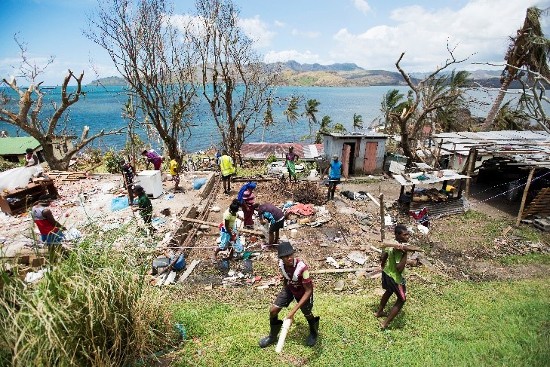What will be the impact on agricultural production of increases in carbon dioxide and other greenhouse gases?
The American Society of Agronomy, Crop Science Society of America and Soil Science Society of America recently issued a position statement on climate change. In that statement the three societies stated “a comprehensive body of scientific evidence indicates beyond reasonable doubt that global climate change is now occurring and that its manifestations threaten the stability of societies as well as natural and managed ecosystems.” The statement indicated that “changes in climate are already affecting the sustainability of agricultural systems.”
Agriculture’s Impact on Climate
What part is our increasing need to produce food and our pattern of land use playing as a contributor to climate change?
- Deforestation removes the most natural carbon sink on the planet. Forests are great absorbers of CO2. By clear cutting boreal forests in temperate zone countries and through burning of rainforests in tropical countries to clear the land for sugarcane and other cash crops we contribute to the rise of atmospheric CO2.
- Animal husbandry on an industrial scale creates methane (CH4) a gas with 20 times the heat absorption rate of CO2. CH4 sources include not just the gases belched and eliminated from cattle, sheep, goats and other ruminants, but also gases derived from farm animal waste.
- Wetland agriculture such as rice paddy flooding results in the release of CH4.
- Animal waste decomposition contributes to nitrous oxide (N2O) release, with 290 times the heat absorption rate of CO2. Excessive application of nitrogen-based fertilizers also generates N2O.
These three greenhouse gases, CO2, CH4 and N2O represent a significant contributor to atmospheric warming and 10-15% of the total present in the atmosphere can be attributed to agricultural activity.
Climate Change’s Impact on Agriculture
Climate change leads to aberrant weather conditions, temperatures, precipitation, and storms and winds that are destructive to traditional agricultural land use. Six notable climate change impacts are:
- Prolonged higher temperatures affecting early plant growth, flowering, pollination and subsequently the quality and quantity of harvests.
- Precipitation changes leading to either prolonged dry periods, or excessive wet ones contributing to soil erosion, soil saturation and plant desiccation.
- Increased CO2 positively impacting some crops while harming others.
- The combination of higher temperatures, precipitation and increased CO2 interacting with other environmental factors such as ozone leading to reduced yields.
- Modification to soil mitigated by all the above causing loss of fertility, decomposition of organic matter, increased salinity, reduced water capacity, altered biological composition, and increased erosion.
- Changes to local ecosystems introducing insect pests and weeds to areas where they normally were unseen.
How Agricultural Practices Can Change to Mitigate Contributions to Climate Change
In food crop production, the way soil, seeding, cultivation and harvesting are managed can contribute dramatically to reductions in greenhouse gas emissions. Agricultural best practices to increase the sequestering of carbon and other contributors to atmospheric warming include:
- Reduced tillage and the baring of soil between plantings.
- Ending mono culture by rotating crops that farmers plant and harvest.
- Better management of irrigation so that water doesn’t end up in soil where there is no crop cultivation, and excessive water doesn’t cause soil saturation.
- Managing nitrogen-based fertilizer application so that it is appropriately used within the crop life cycle and not excessively applied.
- Planting pulse crops that get their nitrogen from the air and soil bacteria. Such crops include peas, lentils, chickpeas, faba beans, soybean and lupin to name a few.
- Altering cultural practices in rice-growing regions of the world to plant dry rice varieties to eliminate standing water in rice paddies.
According to “The New Atlas of Planet Management,” authored by Norman Myers and Jennifer Kent (University of California Press, 2005) domesticated animals outnumber humans on this planet by a factor of 4. There are 3 times as many chickens as people. The remainder of domesticated animals include ruminants, pigs and domesticated pets. The predominant ruminants include cattle, sheep, goats, buffalo, camels and llamas of which there are approximately3 billion. Ruminants are the principal animal contributors of methane gas.
What changes do farmers have to implement in animal husbandry to mitigate greenhouse gas production?
- Changes to the types of grass grown for consumption by cattle.
- Changes to the mix and types of feeds given pigs and ruminants. For example by feeding pigs reduced dietary protein, and by changing the grain mix to corn and soybean rather than barley and canola, CH4 emissions can be reduced by 20 to 40%.
- Better management of animal waste such as applying manure immediately to dry soil rather than storing it, adding straw or allowing it to remain wet. If stored in water farmers can trap CH4 using impermeable covers and use the vented trapped gas as a fuel for generating heat and electricity.
How Agriculture Can Adapt to Climate Change
As the atmosphere warms and precipitation and wind patterns alter, agriculture will feel the impact. The methods for mitigating contributions to climate are almost the same as those needed to adapt to it. Farmers will have to:
- Change the type of crops they grow particularly if climate zones shift transforming regions, for example, from wet to semi-arid, and from semi-arid to arid.
- Apply soil conservancy techniques to mitigate against wind erosion and other climate change variables.
- Apply drip irrigation to conserve water as farming areas dry out
- Experiment with a wider variety of crops, choosing those most suited to the changing climate.
- Develop new strategies to manage new and unfamiliar insect and weed pests introduced by changes to the local ecosystem.
- Develop closed systems of agriculture using greenhouse technologies such as described in my previous blog about rethinking the farm.
















